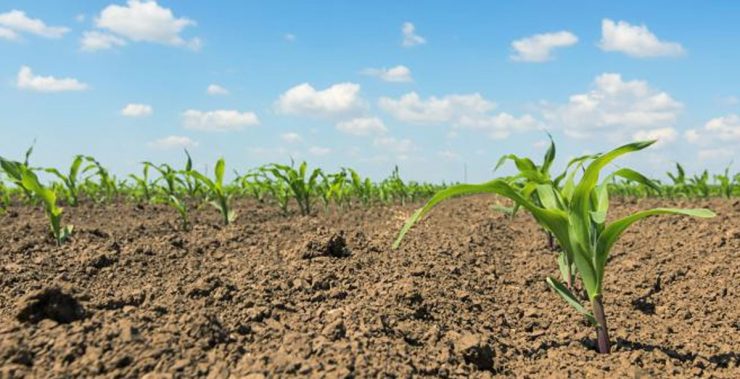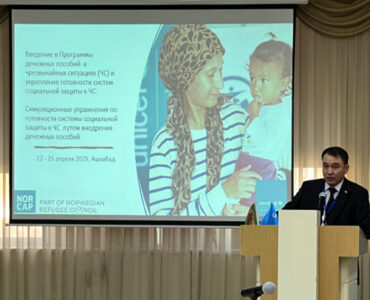Summary: Turkmenistan is among the frontline countries to experience human, economic, and physical consequences of the climate change. As a result of increasing temperatures, evaporation and desertification, the share of agricultural sector as percentage of GDP in Turkmenistan has declined from 30% in the early 90s to 9% in 2015. The agricultural sector is important for Turkmenistan because it affects country’s ability to feed its own people and to ensure food security. Turkmenistan should urgently develop appropriate adaptation measures by boosting resilience to climate stresses and disasters. It should also diversify its agricultural sector by growing crops that are drought and salt tolerant crops.
This summary of research on Turkmenistan and recommendations have been developed by a Turkmen researcher in cooperation with Progres.online. Progres.online is an online analytical journal. Progress promotes a deeper and nuanced understanding of the social and economic trends in Turkmenistan through high-quality research and analysis.
The first part of this research “Turkmenistan: Issues and Potential in Agriculture” can be accessed here.
Climate change and agriculture in Turkmenistan
Development of the agricultural sector and its potential depends on several factors including climate, availability of water resources, quality of land, as well as government’s policies effecting the sector. The agricultural sector in Turkmenistan is underdeveloped while remaining under strict state control. This, along with its low climatic potential and the effects of the climate change make the agricultural sector unable to live up to its potential and ensure food security for Turkmen people.
Turkmenistan has significant vulnerability to climate change. According to the recent IMF report, the Middle East and Central Asia (ME&CA) region is on the frontline to experience human, economic, and physical consequences of the climate change. In this region the global warming exacerbates desertification, water stress, and rising sea levels. Such trend can lead to serious economic disruptions, threaten food security, and challenge public health, with ripple effects on poverty and inequality, displacement, and conflict. Therefore, countries like Turkmenistan need to adapt to climate change by boosting resilience to climate stresses and disasters.
Analysis of data from the past century shows that ME&CA region’s three main climate stresses have significantly worsened since the 1990s:
- temperatures have risen by 1.5° C (twice the global increase of 0.7° C);
- precipitation has become more erratic than in any other regions;
- climate disasters (e.g., droughts, floods) have occurred more often than in the past.
Moreover, since 2000 climate disasters have led to, on average per year, $2 billion in direct material damages, 7 million affected people, and 2,600 deaths. In Caucasus and Central Asia Kazakhstan and Turkmenistan are currently emitting above the global average per person.
Turkmenistan is likely to see temperatures rise more than elsewhere, with average temperatures estimated to exceed 30°C by 2050. Higher temperatures combined with lower and more irregular rainfall will deplete soil moisture and increase evaporation. This can lead to drying out of rivers and lakes (e.g., the Caspian Sea). They will also accelerate desertification and aridity in Turkmenistan (IMF, 2022). It is estimated that 16% of land in Turkmenistan is subject to moderate desertification, and 6% is susceptible to high desertification. Ineffective local land management practices make such trends even worse while also leading to increased dust storms (The World Bank, 2021). Furthermore, the World Bank predicts significant increase in droughts, which can speed up the process of desertification in the absence of mitigation efforts. Much of Turkmenistan’s land surface might become hyper-arid by 2041–2071. Land degradation and aridity will negatively affect the biodiversity and ecology while reducing productivity of land in Turkmenistan with serious repercussions on food security (The World Bank, 2021).
In addition, Turkmenistan suffers from salinization in the cotton-growing regions of the Garagum desert irrigated by Amu Darya. The Garagum desert suffers from severe droughts and contains two million acres of salt marshes. Moreover, drying of the Aral Sea also has a negative impact on the health of the local population (Facts and details). Salinity (salt content in the soil) and to a lesser extend sodicity (accumulation of sodium) are serious challenges faced by Turkmenistan (ICARDA, 2009). Sandy soils with sparse vegetation and hot and arid climate are most prone to wind erosion. For example, about 80% of the soils in Turkmenistan are sandy and highly susceptible to erosion if disturbed. Activities such as overgrazing, vehicular traffic and oil exploration in desert areas causes such disturbances (ICARDA, 2009). The Table 1 illustrates the share of problematic land in Central Asian countries.
Given the dry climate and high average summer temperatures, agricultural sector in Turkmenistan relies heavily on irrigation. As a result, any changes in the water supply from the Amu Darya River will influence the agricultural output. The rising temperatures will increase the rate of melting in the glaciers feeding the Amu Darya as well as increase the rate of evaporation and transpiration, which in return will increase demand for irrigation (The World Bank, 2021). UNDP estimates the drop in the flow of local rivers by more than 30%. Meanwhile, the World Bank predicts that by 2050 countries along the Amu Darya will experience severe water shortages with an estimated 50% of demand going unmet. Water shortages will drastically reduce crop productivity in major crops such as cotton and wheat (The World Bank, 2021). As a result of increasing temperature of the air, decreasing amount of precipitation, increasing water scarcity, lack of additional sources of surface water, growing population and growing needs of the population for food products, it will be extremely difficult for Turkmenistan to ensure country’s food security (UNDP).
Climate change can influence food production via direct and indirect effects on crop growth processes (The World Bank, 2021).
Direct effects include:
- alterations to carbon dioxide availability;
- precipitation and temperatures.
Indirect effects include:
- availability of water resources;
- seasonality of water resources;
- soil organic matter transformation;
- soil erosion;
- changes in pest and disease profiles;
- appearance of invasive species;
- decline in arable areas due to the salinization and desertification.
Moreover, the economic impact of climate change will be severe in Turkmenistan. As 60% of the country’s agricultural land is being salinized, the crop yields have fallen by 20%–30% in recent years. Similarly, rising temperatures via evaporation and lower soil moisture is likely to reduce crop productivity while reducing the revenue generated by irrigated agriculture. In addition, extreme heat may also affect livestock farming via heat stress on the animals and lower productivity of pasture. The expected increase in drought may also severely effects availability of pasture for the livestock. For instance, during the severe drought in 2000–2001 the available pasture dropped by 40% and 70%, respectively (The World Bank, 2021).
Another influence of climate change on agricultural production is through its impact on the labour force, their health and productivity. As suggested by Dunne et al. (2013) the global labor productivity during peak months has already dropped by 10% due to global warming. It is estimated that by 2050 the labour productivity might drop by 20%.
What is the future of agriculture in Turkmenistan?
The agricultural sector is important for Turkmenistan because 47.5% of its population live in rural areas (The World Bank, 2020). The sector also effects country’s ability to feed its own people and to ensure food security. According to the UNDP, some of the things Turkmenistan will need to consider are:
- introducing system of paid water use;
- intensifying use of modern technologies to ensure efficient usage and savings of irrigation water (UDNP);
- cultivating more drought-resistant and salt-tolerant agricultural crops.
The changing climate and increase in temperature will further increase water evaporation making it difficult to sustain productivity of irrigated land. This is why it is crucial for Turkmenistan to improve water productivity and reduce water pollution and water salinization. This, however, will depend on country’s ability to incentives efficient water usage, to effectively transfer water management to local users, invest in better technologies, and regulate externalities more effectively (ICARDA, 2009).
Turkmenistan should also diversify its agricultural sector and focus on areas of comparative advantage given its climatic potential. It could grow crops that require a lot of sun, warm climate and less water (ICARDA, 2009). For instance, sorghum (mekgejöwen) and pearl millet (galla ösümligi), chickpea (nohut) and oilseed crops (ýag tohumy ekinler) are known to be drought and salt tolerant crops. These crops can be grown successfully together with salt tolerant grasses and shrubs in marginally saline, rainfed and in irrigated areas after the wheat harvest. This will help control salinity, increase productivity of those areas and provide additional sources of income (ICARDA, 2009). Likewise, maize, pigeon pea and other grain legumes have the potential to partially meet household energy requirements in rural areas.
Donate to support Turkmen analysts, researchers and writers to produce factual, constructive and progressive content in their efforts to educate the public of Turkmenistan.
SUPPORT OUR WORKFurthermore, initial results in Turkmenistan and Uzbekistan with different fast growing pigeon pea (mäş) varieties, have been very encouraging as erosion control measure. Similarly, potato and vegetable crops are among the most profitable diversification crops with significant potential to contribute to poverty reduction. In Turkmenistan, these crops are generally grown by smallholder farmers who are among the poorest group. For example, cultivation of potato under laboratory conditions in Tajikistan and Uzbekistan showed high levels of tolerance to heat and drought (ICARDA, 2009).
Productivity of the agricultural sector depends on the availability of fertile land, water recourses and climate conditions. Hence, effective and efficient water and land management is crucial for Turkmenistan to meet the needs of a growing population, to ensure food security and to develop all sectors of the economy. Turkmen government should provide farmers with the right to (Stanchin, 2016):
- own the means of production, e.g. land, water resources;
- use the means of production at their own discretion;
- distribute the results of their work;
- sell products at their own discretion;
- make independent decisions on any production cycle.
By creating a personal interest among farmers in the final results of their work, government can incentives the rural producers to become the owners of agricultural production and get prepared for climate change. Since farmers’ own well-being will depend on the results of their labor, they will make every effort to increase the volume of production, reduce the cost per unit of output and increase the profit (Stanchin, 2016).
Turkmenistan should urgently consider the risks posed by climate change and develop appropriate adaptation measures by boosting resilience to climate stresses and disasters. To this end the IMF suggests:
- embedding climate adaptation in country’s medium-term inclusive growth agenda;
- introducing social measures such as social protection, health care, and education;
- making infrastructure investments in water and early warning systems;
- involving the private and financial sectors to play their part.
Furthermore, to address the negative effects of the climate change and invest in greater resilience and better adaptation Turkmenistan will need financial resources. IMF estimates that countries in the Middle East and Central Asia will need up to 3.3% of GDP per year over the next ten years. Given this, IMF suggests several ways to mobilize domestic finances including the following options:
- Introducing a carbon taxation – taxing the production and uses of fossil fuels. For instance, if Turkmen government introduced a tax of $25 per ton of carbon it could collect almost 3% of GDP in fiscal revenues and 6% with a tax of $75. These additional funds could be used to compensate people negatively affected both by the use of fossil fuels and by government’s measures to reduce the use of fossil fuels.
- Removing fuel subsidies – it could help cover the substantial adaptation costs. However, it is essential to implement a well-targeted social transfer systems (e.g., cash transfer) to the most vulnerable.
Turkmenistan has no time to waste. Climate is changing and negatively impacting people and their ability to live, survive and thrive. As the Turkmen saying goes, ‘it is better late than never.’ This is why the time to act is now, and we encourage the Turkmen government to take the necessary measures, to educate the public and to introduce social safety nets to support those most affected by these changes.
Sources used
Dunne, J. P., Stouffer, R. J., & John, J. G. (2013). Reductions in labor capacity from heat stress under climate warming. Nature
Climate Change, 3(6), 563–566.
Facts and Details (2016). “Agriculture in Turkmenistan.”
The Food and Agriculture Organization (FAO) (2014). “Project on Conservation Agriculture in Irrigated Areas of Azerbaijan, Kazakhstan, Turkmenistan And Uzbekistan.”
International Center for Agricultural Research in the Dry Areas (ICARDA) 2009, “A Vision for Sustainable Land Management Research in Central Asia.”
International Monetary Fund (IMF) (2022).“Feeling the Heat: Adapting to Climate Change in the Middle East and Central Asia.”
Qamar, Kalim (2013). “Integrating Nutrition into Rural Advisory Services and Extension: Turkmenistan.” Global Forum for Rural Advisory Services (GFRAS).
Stanchin I.M (2015). “The History of Forming the Potential of Irrigated Agriculture In Turkmenistan.”
Stanchin I.M (2016). “Natural and Economic Potential of Turkmenistan.”
The World Bank (2021). “Climate Risk Country Profile: Turkmenistan.”
Volmuradov Gurbangeldy Meredovich, “Water Resources of Turkmenistan: Potential, Use, Technology and Ecology.” Ministry of Water Resources of Turkmenistan.







